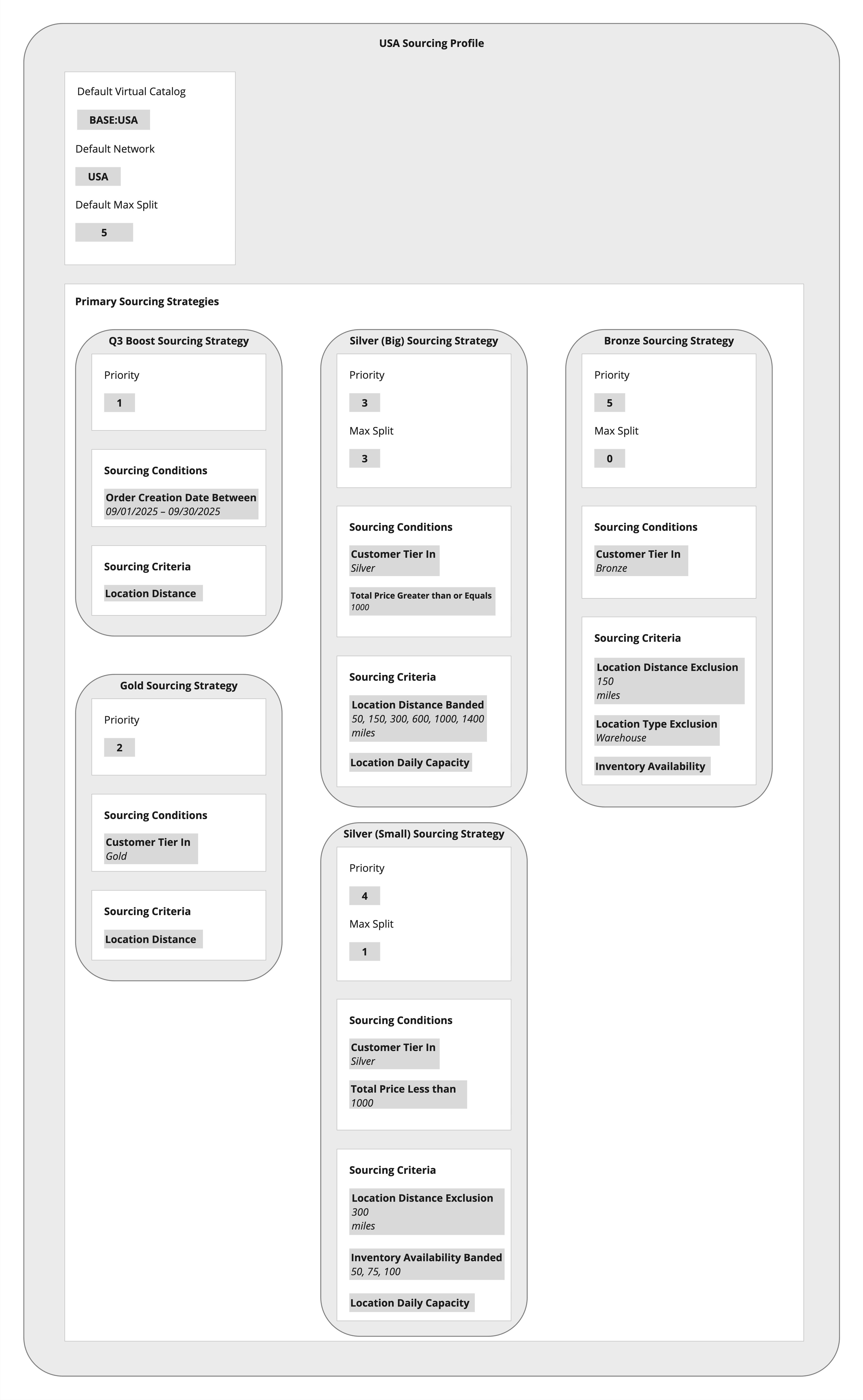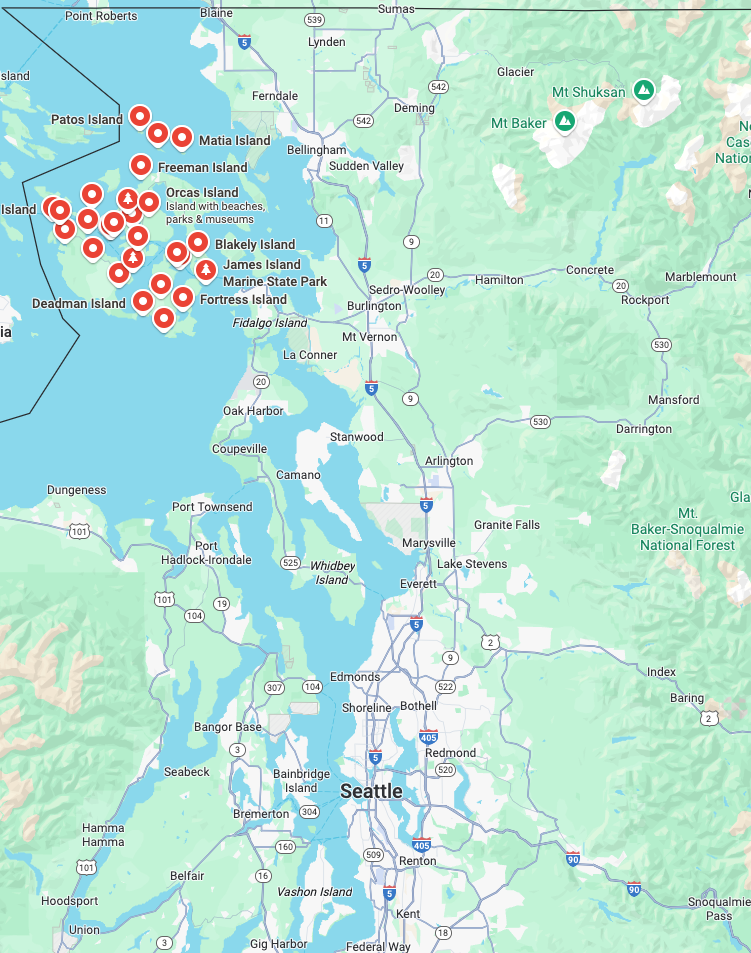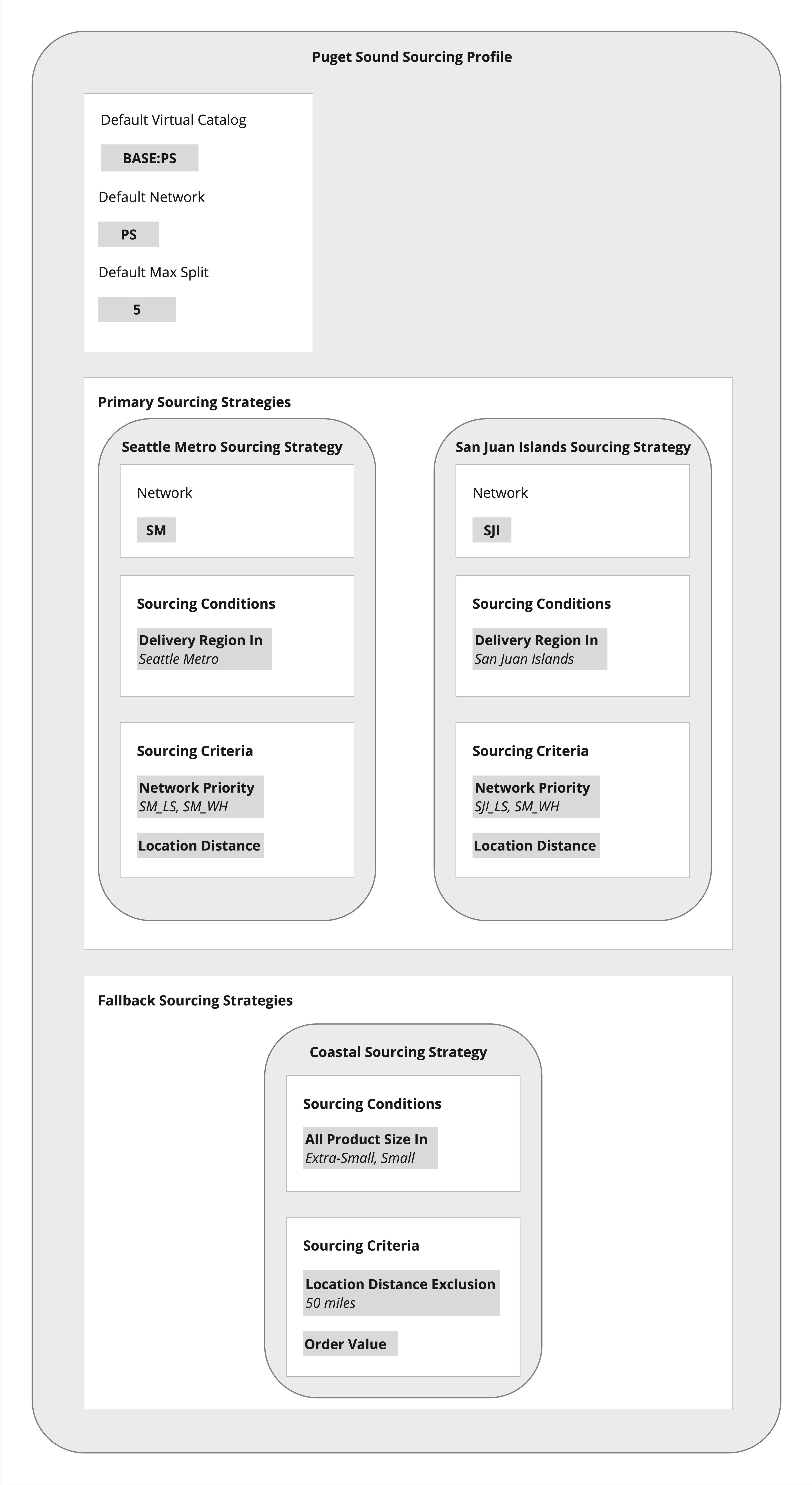Introducing Data Model and GraphQL APIs for Responsive Sourcing Framework
Author:
Darren Brice
Changed on:
29 Sept 2025
| Target release date: | 2025-09-29 |
|---|---|
| Release status: | Released |
Description
Responsive Sourcing is a next-generation sourcing engine that adapts to business context, not just static rules. It makes complex sourcing logic intuitive and accessible beyond technical teams.
This first Responsive Sourcing release provides the extended Data Model and foundational GraphQL APIs in order to be able to create, read and update all of the elements that form your Responsive Sourcing capability. This includes Sourcing Profiles, Sourcing Strategies, Sourcing Criteria and Sourcing Conditions.
Core Building Blocks
- Sourcing Profiles: Group multiple sourcing strategies to manage order fulfillment logic efficiently. Referenced within workflows (Order or Availability) to determine which sourcing approach applies to incoming orders.
- Sourcing Strategies: Define structured approaches for determining optimal fulfillment locations. Each strategy contains sourcing conditions and criteria, with priority-based evaluation when multiple strategies apply.
- Sourcing Conditions: Specify when a sourcing strategy applies based on order, product, or customer information. Uses comparison operators (equals, greater than, contains) to evaluate attributes like customer segment or product classification.
- Sourcing Criteria: Function as cost evaluation mechanisms to rank and prioritize fulfillment locations. Each criterion assigns float values where lower scores indicate preferred locations, and criteria are evaluated sequentially for tie-breaking.
Key Benefits
🚀 Faster Implementation
Simplify the configuration and management of complex sourcing logic, reducing reliance on custom Workflows and technical teams
👥 Business User Empowerment
Empower both business and technical users to define, adjust, and optimize Sourcing Strategies quickly and confidently
📈 Improved Performance
Accelerate project implementations by providing an extensible library of commonly used sourcing logic
🔄 Operational Agility
Increase agility by allowing you to adapt Sourcing Strategies to evolving fulfillment conditions and business needs
📢 Future Development Announcement
The Improvements highlighted above are the required Backend changes that will drive the User Interface capabilities planned for release later in 2025. The Responsive Sourcing User Interface, will provide more ways for Fluent OMS users to fine-tune how their sourcing engine responds to the needs of their business. It will provide an intuitive, adaptable configuration experience allowing users to react to changes in the sourcing needs of the business, faster than ever before.
📖 Check the Overview to learn more.
Changelog
Initial release
| Released capability depth: | New capability |
|---|---|
| Release bundle / Capability type: | Platform |
Use cases
Setting Up Country-Specific Sourcing Logic
Problem
European fulfillment spans multiple countries with distinct regulations, market dynamics, and logistical considerations. To ensure efficient, compliant, and cost-effective order fulfillment, the sourcing system must account for country-specific restrictions, operational priorities, and geographic constraints.
Key constraints to address include:
- Country-specific supply networks: Each country operates its own network of local stores and warehouses, and sourcing must prioritize inventory availability within the correct national network before considering cross-border fulfillment.
- Regulatory restrictions: Certain products cannot be imported across borders due to legal or safety regulations.
- Operational priorities: Different regions may use different sourcing criteria, such as distance thresholds, capacity limits, or network prioritization.
- Geographic delivery limitations: Some sourcing routes are excluded if the delivery location exceeds a defined distance.
Why It Matters
Without country-aware sourcing logic, businesses risk violating regulations, incurring excessive cross-border shipping costs, and introducing unnecessary delivery delays. Implementing country-specific rules ensures compliance, reduces transportation expenses, and improves fulfillment speed and reliability.
Example
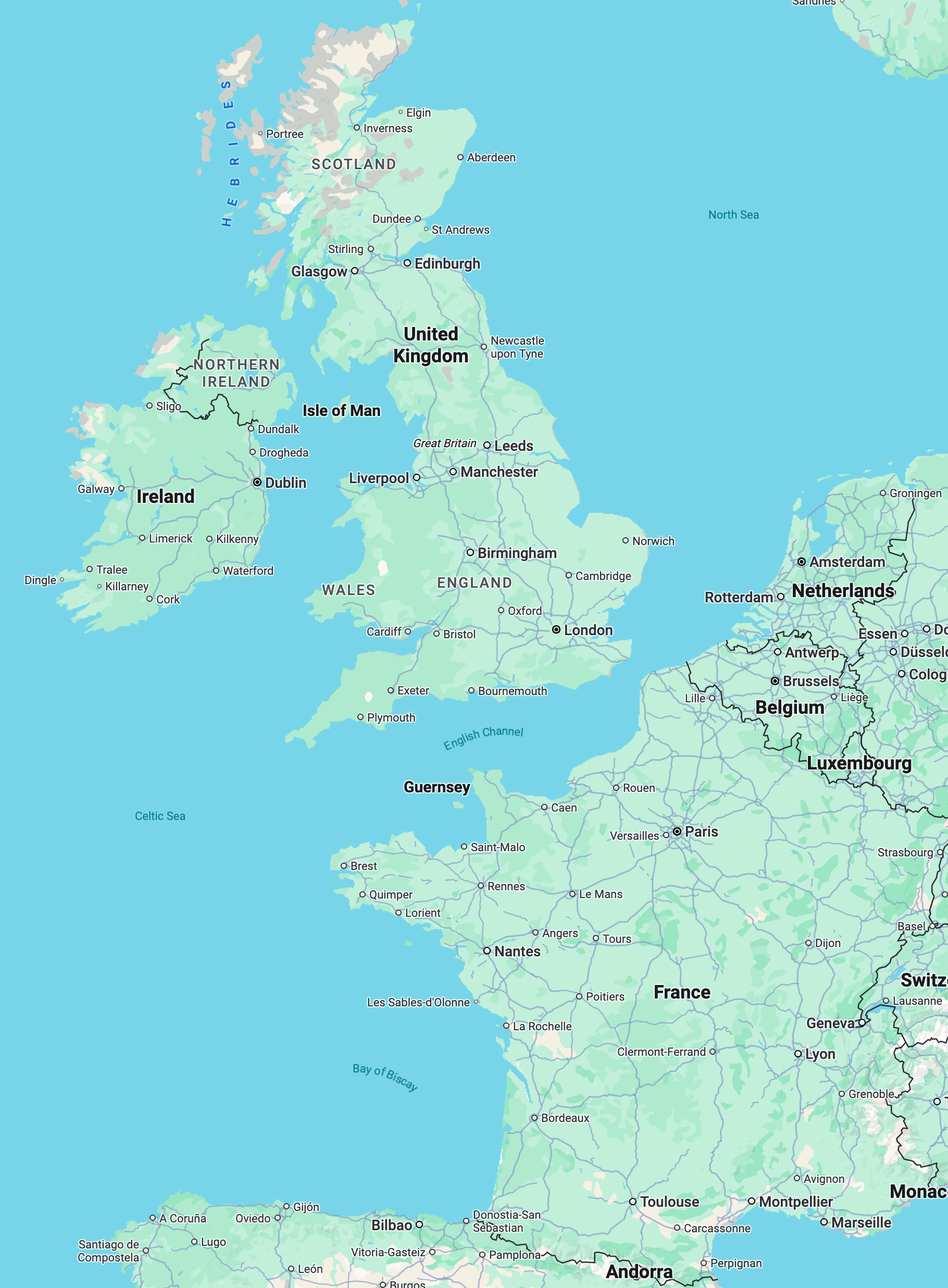
A retailer operates in United Kingdom, Belgium, and France, with each country’s local stores and warehouses grouped into their respective networks:
`UK_LS`and`UK_WH`for United Kingdom`BEL_LS`and`BEL_WH`for Belgium`FRA_LS`and`FRA_WH`for France
Sourcing priority
General
- Priority is given to local stores within the regional network of the same country
- The next choice is local stores within the regional network of a neighboring country
- The last choice is any available warehouses
United Kingdom
- If the order contains any Jewellery category items, source exclusively from U.K. networks (
`UK_LS`,`UK_WH`) to comply with import restrictions - Apply tiered distance bands to prioritize closer fulfillment points first, reducing transit times and shipping costs while maintaining service-level agreements (SLAs)
- Respect daily maximum order capacity to prevent operational overload, maintain consistent service quality, and avoid delays during peak demand periods
Belgium
- Prioritize fulfillment from Belgian local stores (
`BEL_LS`) first, then from France (`FRA_LS`) if needed - Apply distance-based prioritization to ensure efficient cross-border delivery only when necessary
France
- Prioritize French local stores (
`FRA_LS`), then source from Belgium (`BEL_LS`) if domestic stock is insufficient - Apply distance exclusion to meet delivery expectations, avoid excessive transit times, and maintain service quality.
- Ensure that the sourcing logic always considers real-time inventory levels to minimize partial shipments, backorders, or cancellations caused by stock shortages
Solution
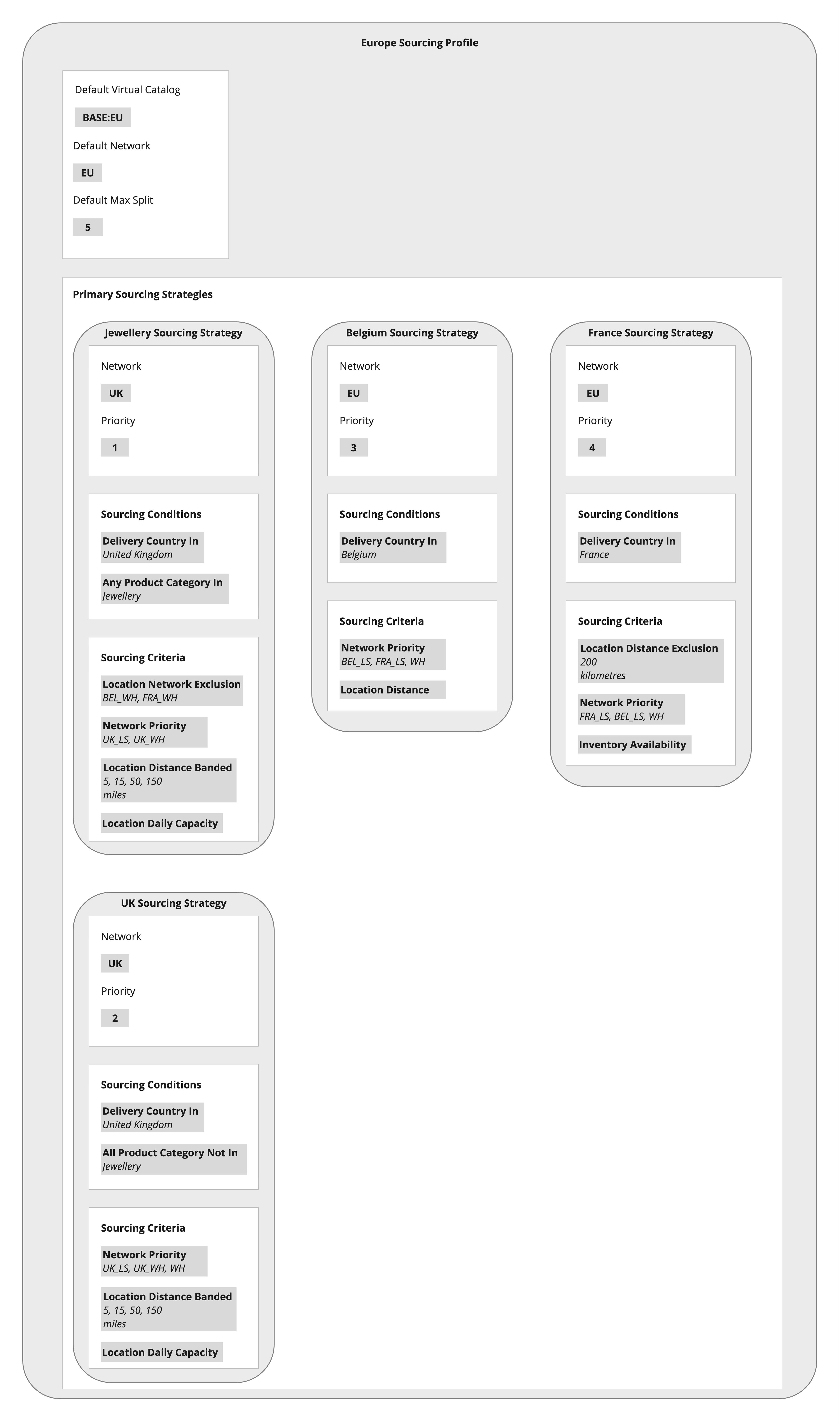
Setting Up Customer-Specific Sourcing Logic
Problem
Customer segments have different service-level expectations, order patterns, and purchasing behaviors. To meet these needs while ensuring operational efficiency, the sourcing system must apply dynamic rules that adapt fulfillment strategies based on customer tier, order value, or campaign timing.
Key constraints to address include:
- Tier-specific service priorities: Higher-tier customers (e.g., Gold, Silver) may receive faster fulfillment or have access to additional inventory sources compared to lower-tier customers (e.g., Bronze).
- Order value segmentation: Large and small orders within the same customer tier may require different sourcing logic to optimize costs and service levels.
- Promotional or seasonal priorities: Certain sourcing rules may apply only during specific periods (e.g., monthly-based campaigns).
- Distance limitations: Even for high-priority customers, fulfillment must respect distance thresholds to maintain service quality.
Why It Matters
Dynamic sourcing logic provides an opportunity to incentivize loyalty and repeat business. Prioritizing fulfillment by Customer Tier rewards loyalty with an enhanced service promise, and ensure that fulfillment resources are allocated where they have the greatest impact.
Improve service-level compliance, customer satisfaction and operational performance, with just a few clicks.
Example

A retailer in the United States organizes sourcing logic around customer tiers: Gold, Silver, and Bronze. Each tier has defined priorities, distance rules, and capacity limits, with special handling for high- and low-value orders within the Silver tier.
Sourcing priority
- Priority is determined first by promotional eligibility, then by customer tier, and finally by specific order characteristics such as order monetary value
- Higher-tier customers have access to more varied fulfillment sources
- Sourcing respects distance-based prioritization, Location Daily Capacity rating, and real-time inventory levels
Solution
